
| What is Flavor and Fortune? |
| How do I subscribe? |
| How do I get past issues? |
| How do I advertise? |
| How do I contact the editor? |
Read 12873865 times
Connect me to:
| Home |
| Articles |
| Book reviews |
| Letters to the Editor |
| Newmans News and Notes |
| Recipes |
| Restaurant reviews |
| Article Index (all years, slow) |
| List of Article Years |
| Article Index (2025) |
| Article Index (last 2 years) |
| Things others say |
| Related Links |
| Log In... |
| Authors |
| Categories & Topics |
Fruits: Unusual Ones the Chinese Love
| by Jacqueline M. Newman |
Fruits, Desserts, and Other Sweet Foods
Spring Volume: 2018 Issue: 25(1) pages: 25 to 30
Fruits are flavorful and fantastic, and four previous issues did discuss a large number of them. If you missed them, those were in volumes F23(3), F23(4), F24(1), and F24(2). Before them, sporadic information is elsewhere, so do look at the master web list at www. flavorandfortune.com and while there, check the master recipe index for fruit recipes, too. This particular article discusses eight unusual fruits the Chinese do adore including the custard apple, jack fruit. Jujube, mangosteen, rambutan, quince, star fruit, and the wax apple. (JMN)
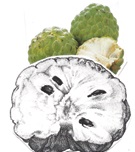 Custard apple is botanically known as
Annona reticulata, and is a light green tropical fruit
that includes many black seeds. Some know it as
‘Bullock’s Heart” and we know not why. Chinese say
this fruit is wonderful even though their leaves smell
dreadfully if crushed. That aroma can be distasteful
as can their shape when lopsided. Nonetheless, these
fruits are adored by many in Asia when ripe and sweet.
They really do taste like custard when chilled.
Custard apple is botanically known as
Annona reticulata, and is a light green tropical fruit
that includes many black seeds. Some know it as
‘Bullock’s Heart” and we know not why. Chinese say
this fruit is wonderful even though their leaves smell
dreadfully if crushed. That aroma can be distasteful
as can their shape when lopsided. Nonetheless, these
fruits are adored by many in Asia when ripe and sweet.
They really do taste like custard when chilled.
Chinese folk tell us their leaves make a fine fumigant, their juice can get rid of lice, and their seeds and leaves when ground and liquified do make great insecticides. Their seeds are many and in pockets of their flesh. They are very creamy, and once we did count fifty-two in a single fruit.
TCM folk say that as a poultice they are good to reduce boils, abscesses, and ulcers when ground. When unripe, dried in the sun, and made that way, they recommend them to those with diarrhea or dysentery. In addition, the bark of their trees or their roots can reduce toothaches while their fruits are used to treat epilepsy and convulsions.
| Custard Apple Dumplings |
|---|
2 custard apples, pits discarded and fruit mashed
1. Mash and mix the custard apple flesh, rambutan
pieces, pomegranate seeds, mashed or cut banana
pieces, and banana flower pieces with the honey or
Osmanthus paste, and mix this well.
|
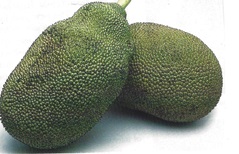 Jackfruit is the world’s largest edible fruit
from a tree. Botanically known as Artocarpus
heterophyllusr, there are smaller versions and many
appreciate them. The big ones can weigh between
twenty-five and one hundred pounds and are hard to
carry home from any marketplace. Many purchase just
a cut piece cut from a large one to manage that chore.
Related to the fig, but hard to believe, they have similar
numbers of seeds, but in this fruit they are huge by
comparison.
In the past, one could not purchase all or part of these
fruits in non-tropical areas where they could only
be had canned or frozen. Not so any more. Now, the
fresh ones are found in the US and other non-tropical
countries with some grown in southern Florida near
Miami and places with similar temperatures. They
are available and getting popular in many more places
nowadays.
Jackfruit is the world’s largest edible fruit
from a tree. Botanically known as Artocarpus
heterophyllusr, there are smaller versions and many
appreciate them. The big ones can weigh between
twenty-five and one hundred pounds and are hard to
carry home from any marketplace. Many purchase just
a cut piece cut from a large one to manage that chore.
Related to the fig, but hard to believe, they have similar
numbers of seeds, but in this fruit they are huge by
comparison.
In the past, one could not purchase all or part of these
fruits in non-tropical areas where they could only
be had canned or frozen. Not so any more. Now, the
fresh ones are found in the US and other non-tropical
countries with some grown in southern Florida near
Miami and places with similar temperatures. They
are available and getting popular in many more places
nowadays.
Some say these fruits resemble large watermelons. We do not see that because their colors inside and out are different as are their textures. Some have crocodile-like skin and a central core of huge radiating seeds, some have sweet, chewy, and sometimes stringy flesh, and a few have a smooth skin. Recently we learned they now grow lots of them in China.
Diabetics should avoid eating these fruits even though TCM practitioners report they are anti-aging with antioxidants galore because of their high sugar content. Round or oval at their ends, they fascinate as they also grow on main branches, tree trunks, and occasionally on exposed roots. When ripe, many tell us they are hard to resist because they taste like a mixture of cantaloupe, mango, pineapple, and Juicy Fruit gum.
Named from the corruption of a Malay word that means round, unripe, and earth-colored, they do become pale to deep green when ripe, some dotted with external spines. Farmers tell us they can feed them to their livestock even when the insides look like rags and have a rubbery texture.
We suggest oiling ones hands, knife, and cutting board before handling or cutting them so they do not stick to these surfaces. A few tell us their aroma is offensive when doing so, but we have not found that to true. We know their nutrient content includes huge amounts of carbohydrate, and when unripe, some tell us they like this fruit as a vegetable and not a fruit. They say to stir-fry it with lots of oil, and/or put it in soup or salad. One chap said he found some in ice cream with their seeds removed.
Many use this fruit boiled or roasted, even pickled, and some do use the wood from its trees to make furniture or musical instruments. Years ago, the dye in their sap was used to color the robes of Buddhist monks. That source is no longer needed as there are cheaper and better sources for it.
| Jack Fruit Salsa |
|---|
6 to 8 ounces of jackfruit flesh, mashed
1. Marinate jackfruit flesh with all other ingredients for
two hours In a glass or ceramic bowl.
|
 Jujubes can be red, brown, or black and these
dates, in Chinese, are called hong zao. Their colors are
common, many only when ripe. When unripe, they
are green. Often called dates, they are available in
hundreds of varieties, many wild; their trunks grafted
on different wild roots. Popular from Leling in the
Shandong Province where more than eight million trees
produce about ten thousand or more tons when dried,
about a thousand tons of these dates are exported
annually.
Jujubes can be red, brown, or black and these
dates, in Chinese, are called hong zao. Their colors are
common, many only when ripe. When unripe, they
are green. Often called dates, they are available in
hundreds of varieties, many wild; their trunks grafted
on different wild roots. Popular from Leling in the
Shandong Province where more than eight million trees
produce about ten thousand or more tons when dried,
about a thousand tons of these dates are exported
annually.
Loved for their sweetness, the honey jujube variety is sweetest with a content of almost eighty percent sugar. All dates are known for their sweetness when ripe, also for their many medicinal uses. Loved fresh and dried, also canned or cooked, TCM practitioners say they are warm, their medicinal properties many, and they have eighty to one hundred percent more Vitamin C than a single apple. They have other vitamins, as well, including iron, calcium, and phosphorus. Some jokingly call them a ‘vitamin pill.’
Botanically, these are Ziziphus jujuba in the Buckthorn family more recently called the Planatarum family. Some call them Rhomnus zizyphus; we know not why. Many Chinese refer to them as hong zao, and almost all love them in syrups, in wines and liquors, and in vinegars and other liquids. We love them in bakery products, fresh or dried, and in many cooked dishes, and cut up and in salads.
TCM practitioners tell us they are great stress reducers thanks to their high sugar content. There is conflicting information about their role in contraception, pro and con, and several told us they have put five or eight of these fruits in the beds of their newlywed children. Several mothers whose children recently married told us their parents did likewise for them when they were first married.
Most TCM practitioners agree that these fruits are used to treat jaundice and diseases of the spleen and stomach. They also said they are popular when treating indigestion, anemia, insomnia, hepatitis, and even hypertension.
Throughout Southeast Asia, we never found anyone who did not like them one way or another, if ripe. Very few made negative comments about them if not sweet. One chap did as he pointed inside his mouth at a broken tooth. He told us the unripe fruits were the cause. Thus, we recommend them in all fruit recipes when ripe and after removing their pits. That incidentally is a difficult task when they are not ripe.
| Hasma With Lotus Seeds and Jujubes |
|---|
2 Tablespoons dried hasma, soaked overnight, then simmered in water and steamed for one hour
1. Prepare all ingredients, and steam them together for
two to three hours in two cups water. Then drain and do
reserve their liquid.
|
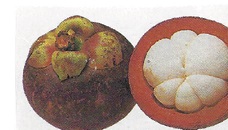 Mangosteen was written about in an
earlier issue shortly after the first time we had ever
seen and tasted them in Taiwan. Finding articles about
them is rare. They are yummy fruits with hard exteriors.
Commonly called the ‘Queens of Fruits,’ they are inedible
unripe with brownish-purple exteriors, but when ripe
and less green-looking, they get darker on their outsides,
their interiors always looking like a litchi or a longan, but
with less juice and with more pits and less aroma. We
once read that their flavor is more like an apple-peach
in combination. They look and taste like their name but
are no relation nor resemblance to any mango we know.
Mangosteen was written about in an
earlier issue shortly after the first time we had ever
seen and tasted them in Taiwan. Finding articles about
them is rare. They are yummy fruits with hard exteriors.
Commonly called the ‘Queens of Fruits,’ they are inedible
unripe with brownish-purple exteriors, but when ripe
and less green-looking, they get darker on their outsides,
their interiors always looking like a litchi or a longan, but
with less juice and with more pits and less aroma. We
once read that their flavor is more like an apple-peach
in combination. They look and taste like their name but
are no relation nor resemblance to any mango we know.
Chinese like them fresh and hot or cold.. Their TCM practitioners use their exteriors for many medicinal needs dried and ground such as to stop diarrhea or control a fever. The leaves, when minced, mixed, and mashed with unripe banana are used as a balm for wounds, their roots when boiled, an aid for those with very irregular menstruation cycles. The fruit does increase energy, reduce weight, improve indigestion, reduce cholesterol, and improve skin and eye health; and often used for one or more of these conditions.
Unusual, these fruits were written about by Carl Linnaeus only a few hundred years ago. He described them in his Species Platarum. That was long before most westerners ever saw, savored, or heard about this fruit, but thanks to him, they learned there were male and female trees, the male ones were rarely found, the female ones often self-propagating;. They also learned these fruits were productive even without fertilization, and that fascinated many of them.
| Mangosteen Fried Rice |
|---|
2 Tablespoons vegetable oil
1. Heat wok or large fry pan, add the oil and stir-fry the
garlic and onion for two minutes.
|
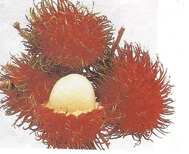 RAMBUTAN a cousin to the li zhi, has a hairy
rubbery exterior that needs discarding. These fruits
grow in clusters, are not as juicy as their loved relation,
and probably did originate in Malaysia because the word
rambut is a Malay word meaning ‘hair’ and their exterior
does have many hairy-like protuberances. Where they
actually came from seems to be in dispute.
RAMBUTAN a cousin to the li zhi, has a hairy
rubbery exterior that needs discarding. These fruits
grow in clusters, are not as juicy as their loved relation,
and probably did originate in Malaysia because the word
rambut is a Malay word meaning ‘hair’ and their exterior
does have many hairy-like protuberances. Where they
actually came from seems to be in dispute.
They are popular throughout Southeast Asia and Australia, their fruits have white flesh that can be a bit yellowish, and they have hard inedible seeds; edible only when ground and cooked. The fruit is best raw and ripe. There are many new species, all are delicious if ripe, all high in Vitamin C, and all producing two crops a year. Most are large and red when ripe, most grow in bunches, and these fruits stay refrigerated longer than most other fruits, and many love them for that.
Celebrated at festivals in many countries, they are made into syrups and alcoholic beverages, and loved as fruits. Their season is long, often March to October, and most enjoy them peeled and wolfed down after they discard their easy to spit out pits. Their flesh has a sweet-sour taste even when not completely ripe, and their pulp travels well so even when found peeled, pitted, and in plastic bags. This fruit is also sold in cans, frozen, in bakery products, as a juice, and as components of many medicines, sometimes made with other fruits, rinds or ground pits.
| Eight Treasure Steamed Rice |
|---|
8 different dried fruits and nuts such as pit-free rambutan pieces, dried and soaked until soft Chinese black or brown dates, quartered pit-free apricots, and other soaked soft seeds until eight have been selected and soaked, as needed
1. Line a steamer basket with muslin or cheesecloth rung
out in cold water.
|
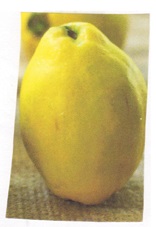 Quince are best picked unripe and better eaten
fragrant and ripe. This yellow-green fruit is often
compared to pears, we know not why, but do know not
to let them touch each other when ripening. Why not,
when they do, they bruise and deteriorate faster had
they not. We also know that Virgil called them ‘golden
apples’ and many still do centuries later even though
they are not related to any apple we know.
Quince are best picked unripe and better eaten
fragrant and ripe. This yellow-green fruit is often
compared to pears, we know not why, but do know not
to let them touch each other when ripening. Why not,
when they do, they bruise and deteriorate faster had
they not. We also know that Virgil called them ‘golden
apples’ and many still do centuries later even though
they are not related to any apple we know.
Appreciated then and now when cooked, they maintain their shape for a long time whether poached, baked, braised, or stewed. They have lots of pectin, more when unripe than ripe, and are great in or with jams, jellies, marmalades, and chutneys.
The Chinese call them mu kua, and botanically they are Cydonia oblonga. Some botanists call them Cydonis vulgaris or C. sinenesis, all know the Chinese quince has different specie names. These fruits can weigh ten pounds or more, can be huge, and when carved can be beautiful. They are often used in medicines and perfumes, and in wines and other potent drinks. Their pectin content helps lower blood cholesterol and provides some protection against heart disease. Their high Vitamin C and good source of potassium is appreciated. Their seeds are less so as they contain myaglandalin, a natural cyanide that breaks down into hydrogen cyanide in the stomach, so do not consume them alone or in quantity.
Cultivated in China since earliest times, these were sacred fruits presented as tokens of love, eaten at a wedding breakfasts, and known as ‘stomach comforters; why we do not understand. When made into syrups, the Chinese use them to treat diarrhea, soreness in the mouth, as a digestive, a thirst reliever, and as a diuretic. The seeds were and still are used prescribed for cholera, cosmetics or incense. Their bark was used to treat ulcers, but rarely is any more, just as they are now rarely used in many medicines.
| Lamb and Quince |
|---|
2 pounds of boneless lamb, any fat discarded
1. Cut lamb into two-inch pieces and add it and the
shortening into a heavy casserole and brown the meat.
|
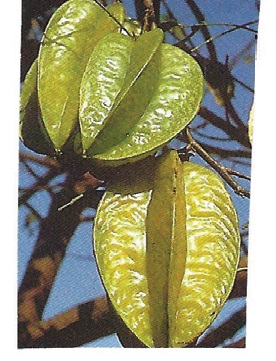 Star Fruit is tropical and juicy. Also known
as carambola and in the genus Averrhoa, they grow
well in sandy soil, three or four fruits found together
often on their tree trunks. These fruits look waxy and
translucent, can be pale yellow to amber, and with angles
that when cut cross-wise resemble a five-pointed star.
The Chinese like them very ripe or made into a juice.
Their TCM practitioners say that fresh and less than
ripe they cure hangovers and can be used as a poultice
to relieve itching from prickly heat. They have lots of
vitamins A and C, considerable iron, and lots of fiber,
and folks need to know the thicker ones are usually the
sweeter ones.
Star Fruit is tropical and juicy. Also known
as carambola and in the genus Averrhoa, they grow
well in sandy soil, three or four fruits found together
often on their tree trunks. These fruits look waxy and
translucent, can be pale yellow to amber, and with angles
that when cut cross-wise resemble a five-pointed star.
The Chinese like them very ripe or made into a juice.
Their TCM practitioners say that fresh and less than
ripe they cure hangovers and can be used as a poultice
to relieve itching from prickly heat. They have lots of
vitamins A and C, considerable iron, and lots of fiber,
and folks need to know the thicker ones are usually the
sweeter ones.
TCM practitioners tell us their leaves and roots cure headaches, reduce ringworm, remove some itching from chickenpox and scabs, and they help heal sore eyes. They tell nursing mothers these fruits increase their milk. Elders advise that pickled in vinegar or dried with salt or cured with sugar, they improve age-related illnesses. Younger folk say they are great in salads if mashed or sliced, and they ease sore throats, and nourish and quench thirst.
| Star Fruit Beverage |
|---|
5 star fruits, their star edges discarded
1. Thin slice the star fruit removing all seeds.
|
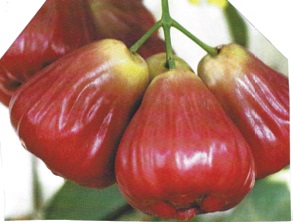 Wax Apple is also
known as ‘black pearl’ or ‘Taiwanese Black Apple’ it is a
fruit new to Taiwan in the last seventy-five or so years.
Now cherished there and in Northeast China, they have
shiny deep red skins and are called ’the diva of expensive
fruits.’
Wax Apple is also
known as ‘black pearl’ or ‘Taiwanese Black Apple’ it is a
fruit new to Taiwan in the last seventy-five or so years.
Now cherished there and in Northeast China, they have
shiny deep red skins and are called ’the diva of expensive
fruits.’
Popular in China’s Linpien Rural Township, a small place of only some twenty-five thousand folk, there they produce lots of them, sell them and many betel nuts and coconuts, and are proud of these agricultural commodities. Why, because one-third of their land is below sea level, many of their houses with upstairs windows at street levels, and roofs just a step or two above their sidewalks. We have not seen this place, but do want to get there soon before their entire houses are below their sidewalks.
Wax apples are tropical fruits getting lots of attention. Many grow protected by a bag to keep birds from snacking on them, others in fields covered with black mosquito netting to keep them away, reduce labor, and eliminate pesticides. Originally from the Malay peninsula, Dutch settlers brought them to Taiwan from Java in the 17th century, and now many grow showing black just below their deep red exteriors. Recently we did learn some bring one hundred US dollars a pound, many weighing that much or more.
| Apple-Pear Compote |
|---|
½ cup haw fruit, simmered for twenty minutes, then cooled and set aside
1. Mix sugar and two cups of water and bring to the boil,
then cool somewhat before adding the haw syrup and the
apple and pear pieces. Simmer these for ten minutes.
|

Copyright © 1994-2025 by ISACC, all rights reserved
Address
3 Jefferson Ferry Drive
S. Setauket NY 11720